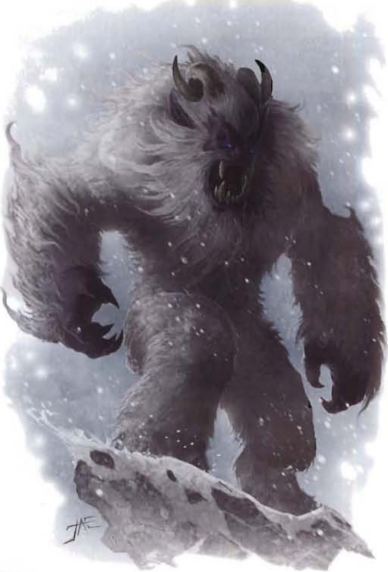Let's Read the 4e Monster Manual 3: Yeti

This article is part of a series! Click here to see the other entries.
Yetis are inspired by real world folklore and I’m sure they showed up in a previous edition of D&D before. This seems to be their 4e debut.
The Lore
D&D yeti are borderline-sapient predators adapted to live in permafrost covered mountains. While they usually feed on other mountain-dwelling animals, they’re more than powerful and ferocious enough to attack people, and so everyone who lives near their habitat knows they exist. Learning how to recognize signs of yeti presence and avoid the creatures is probably a standard part of mountain survival training.
Yetis have a well-developed sense of smell and can track prey across great distances. They hate the smell of rotting flesh, however, so leaving decomposed animal carcasses around an area can serve to keep them away. Herders also know to pay attention to their animals: if they grow too agitated for no apparent reason, it might be because they’ve sensed an approaching yeti.
A yeti relies on its powerful muscles, sharp claws, and magic-enhanced howls to kill its prey. They don’t really have any sort of technology or a complex society, but they live in bands and work very well together. They’re smart enough to avoid large, well-armed expeditions, but they’ll be on top of any isolated stragglers before you can say “Look out, a yeti!”.
The Numbers
Yeti are Medium Natural Beasts with Speed 6, Ice Walk, Resist 5 Cold and Low-Light Vision. Their signature encounter power is their Fearsome Howl, a Close Blast 4 vs. Will that deals psychic damage and pushes 3 squares.
All of the entries here have claws as their basic attacks. These don’t have any riders and are always underpowered for their level, which means they’ll use their other attacks as much as possible. Their other attacks also tend to have low-ish damage, but have interesting riders. They have an Int between 9 and 11 while still counting as Beasts, which is why I said “borderline sapient” above.
Yeti encounters will most often be against an all-yeti group, as they don’t really ally with anyone or keep pets. For variety, you can add other opportunistic predators, or maybe a wild cold elemental or two. Also, these encounters are all pretty much guaranteed to take place in treacherous frozen mountain paths full of ice-based difficult terrain and hazards like tall cliffs and snow-covered sinkholes. Every yeti has at least one forced-movement power available to it (Fearsome Howl), so they’re likely to be more dangerous than their stats alone indicate.
Yeti Hunter
Your typical roaming yeti, whose howls can be heard from miles away but don’t really give away their position because of the way sound echoes in the mountains. It’s a level 3 Soldier with 49 HP.
The hunter’s claw attack will probably only feature as part of a Twin Claw Grab, which lets it make two attacks and grab the target if both hit. It doesn’t have any special abilities to exploit a grab, but the basic rules still apply. Its marking abilities are a ranged How of Challenge that deals psychic damage and marks for a turn, and a close burst Call for Blood that deals more psychic damage and marks everyone it hits (save ends).
Yeti Howler
A yeti whose magic howls are more powerful than usual. Some stories say they’re the embodiment of angry ghosts, howling against the injustice of their premature deaths. They’re Level 4 Controllers with 58 HP.
The howler’s Chilling Wail acts as an aura (3) that deals 5 psychic damage and imposes a -2 defense penalty for a turn against any enemy who ends their turn inside. This actually brings its melee damage up to par, with a little extra aimed at the other PCs inside the aura. If you try to stay away from it, the howler will bombard you with Hurled Boulders that work like ranged area attacks dealing physical damage.
In addition to their Fearsome Howl, howlers can also emit a Piercing Shriek once per encounter. This ranged attack deals thunder damage, and if the target ends their next turn within 5 squares of the yeti they take another 5 thunder damage.
Yeti Rampager
This one is angrier than usual, with a more mobile fighting style. It’s a Level 5 Skirmisher with 67 HP. They have a Speed of 7.
Rampagers love to charge, so they’ll try to make space for those charges as often as possible. They’ll pick a target and use their Battle Howl against it, a ranged attack that deals psychic damage and lets them charge as a free action on a hit. They can also just charge normally instead, if they’re not confident of hitting the target with the howl. In either case their Furious Charger trait gives them +5 bonus damage on charges.
If they’re surrounded by melee PCs, howlers can use Furious Howl or Trample to get away. That last ability lets them shift their speed and make a melee attack that damages and knocks prone on a hit against any enemies whose spaces they move through during the shift.
Final Impressions
Yeti are interesting mechanically, but they require a bit more thought on the part of the GM to ensure they’re dealing level appropriate damage. None of them are the type to stand still and spam basic attacks.
Lore-wise, I don’t see much wrong with their lore. They’re described as dangerous predators, and the word “savage” doesn’t appear even once in this entry. The biggest criticism I can make is that yetis are so iconic outside D&D that facing one feels kinda “mundane” when compared to some of the other monsters available. That’s just a personal taste thing, though.
It wouldn’t be hard to use these stat blocks for a sapient and friendlier yeti if that’s how you want them to be in your campaign.